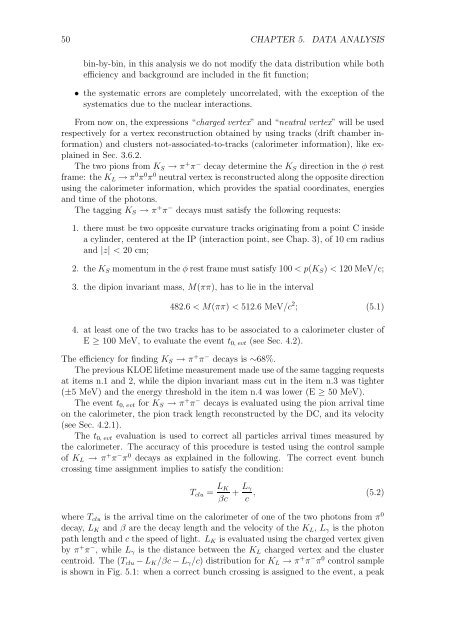Universit`a degli studi Roma Tre Measurement of the KL meson ...
Universit`a degli studi Roma Tre Measurement of the KL meson ...
Universit`a degli studi Roma Tre Measurement of the KL meson ...
Create successful ePaper yourself
Turn your PDF publications into a flip-book with our unique Google optimized e-Paper software.
50 CHAPTER 5. DATA ANALYSIS<br />
bin-by-bin, in this analysis we do not modify <strong>the</strong> data distribution while both<br />
efficiency and background are included in <strong>the</strong> fit function;<br />
• <strong>the</strong> systematic errors are completely uncorrelated, with <strong>the</strong> exception <strong>of</strong> <strong>the</strong><br />
systematics due to <strong>the</strong> nuclear interactions.<br />
From now on, <strong>the</strong> expressions “charged vertex” and “neutral vertex” will be used<br />
respectively for a vertex reconstruction obtained by using tracks (drift chamber information)<br />
and clusters not-associated-to-tracks (calorimeter information), like explained<br />
in Sec. 3.6.2.<br />
The two pions from KS → π + π − decay determine <strong>the</strong> KS direction in <strong>the</strong> φ rest<br />
frame: <strong>the</strong> <strong>KL</strong> → π 0 π 0 π 0 neutral vertex is reconstructed along <strong>the</strong> opposite direction<br />
using <strong>the</strong> calorimeter information, which provides <strong>the</strong> spatial coordinates, energies<br />
and time <strong>of</strong> <strong>the</strong> photons.<br />
The tagging KS → π + π − decays must satisfy <strong>the</strong> following requests:<br />
1. <strong>the</strong>re must be two opposite curvature tracks originating from a point C inside<br />
a cylinder, centered at <strong>the</strong> IP (interaction point, see Chap. 3), <strong>of</strong> 10 cm radius<br />
and |z| < 20 cm;<br />
2. <strong>the</strong> KS momentum in <strong>the</strong> φ rest frame must satisfy 100 < p(KS) < 120 MeV/c;<br />
3. <strong>the</strong> dipion invariant mass, M(ππ), has to lie in <strong>the</strong> interval<br />
482.6 < M(ππ) < 512.6 MeV/c 2 ; (5.1)<br />
4. at least one <strong>of</strong> <strong>the</strong> two tracks has to be associated to a calorimeter cluster <strong>of</strong><br />
E ≥ 100 MeV, to evaluate <strong>the</strong> event t0, evt (see Sec. 4.2).<br />
The efficiency for finding KS → π + π − decays is ∼68%.<br />
The previous <strong>KL</strong>OE lifetime measurement made use <strong>of</strong> <strong>the</strong> same tagging requests<br />
at items n.1 and 2, while <strong>the</strong> dipion invariant mass cut in <strong>the</strong> item n.3 was tighter<br />
(±5 MeV) and <strong>the</strong> energy threshold in <strong>the</strong> item n.4 was lower (E ≥ 50 MeV).<br />
The event t0, evt for KS → π + π − decays is evaluated using <strong>the</strong> pion arrival time<br />
on <strong>the</strong> calorimeter, <strong>the</strong> pion track length reconstructed by <strong>the</strong> DC, and its velocity<br />
(see Sec. 4.2.1).<br />
The t0, evt evaluation is used to correct all particles arrival times measured by<br />
<strong>the</strong> calorimeter. The accuracy <strong>of</strong> this procedure is tested using <strong>the</strong> control sample<br />
<strong>of</strong> <strong>KL</strong> → π + π − π 0 decays as explained in <strong>the</strong> following. The correct event bunch<br />
crossing time assignment implies to satisfy <strong>the</strong> condition:<br />
Tclu = LK<br />
βc<br />
Lγ<br />
+ , (5.2)<br />
c<br />
where Tclu is <strong>the</strong> arrival time on <strong>the</strong> calorimeter <strong>of</strong> one <strong>of</strong> <strong>the</strong> two photons from π 0<br />
decay, LK and β are <strong>the</strong> decay length and <strong>the</strong> velocity <strong>of</strong> <strong>the</strong> <strong>KL</strong>, Lγ is <strong>the</strong> photon<br />
path length and c <strong>the</strong> speed <strong>of</strong> light. LK is evaluated using <strong>the</strong> charged vertex given<br />
by π + π − , while Lγ is <strong>the</strong> distance between <strong>the</strong> <strong>KL</strong> charged vertex and <strong>the</strong> cluster<br />
centroid. The (Tclu − LK/βc − Lγ/c) distribution for <strong>KL</strong> → π + π − π 0 control sample<br />
is shown in Fig. 5.1: when a correct bunch crossing is assigned to <strong>the</strong> event, a peak
















